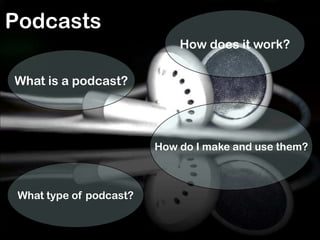Podcasting Basics
- 1. PodcastsHow does it work?What is a podcast?How do I make and use them?What type of podcast?
- 2. What is a podcast?
- 3. Podcasting embodies what I have described as the MartiniâĒ style of mobile computingâAnytime, Anyplace, Anywhere â A podcast is essentially a free, on-demand media file that can be listened to or viewed on a desktop computer, laptop, netbook, mp3 player or mobile phone at a time and place of your own choosing. Depending on your device, this can be on a bus, train, plane, in a car, at work, at home, in the park and so on.
- 4. How does it work?ReallySimpleSyndicationPodcasts are distributed via a web based subscription service (RSS feeds) and each new episode is automatically downloaded to your computerâs âpodcatcherâ or feed reader. You can then transfer the files to your mobile device or listen/view on your computer.
- 5. What type of podcast?AudioThe modern equivalent of a radio programme or audio bookVideoShort video clips - as seen on YouTubeScreencastA method of recording your actions on a computer screen â ideal for short, visual how-to guides
- 6. How do I make a podcast?This does not have to be complicated or expensive. Some free (or cheap) options - using your own computer - include:Audio Use free audio editing software such as Audacity and a microphone to record your audio podcastVideo Use a mini digital recorder such as the Flip or your mobile phone to record your video. Edit in Windows Live Movie MakerScreencastUse free screen capture software such as CamStudio to record and edit your how-to guide
- 7. How do I use podcasts?
- 8. Create added value by producing podcasts of additional materials such as quizzes, imagery, audio / video extracts to encourage reflection, peer review and discussion amongst your students. This can build on the lecture content and enrich the learning experience
- 9. Explore the possibilities of using iTunesU in your University.
- 10. Upload your podcasts to the University VLE (typically Moodle or Blackboard) to enable students to subscribe to your podcast feed in iTunes /Juice or other âpodcatcherâ and download to their iPod/iPhone or other mp3 player/mobile phone. iTunes is free and easy to use on Windows and Mac and you don't have to have an iPod or iPhone to subscribe and download podcasts.
- 11. Students sayâĶâI listen on the train because I sit there and think right - Iâm going to do something productiveââIf I had a spare five minutes Iâd log onto iTunes to get the latest podcast and then if I had to rush off somewhere else, Iâd listen to it later onââI waited until I was ready to start my assignment and then I watched the video podcast and it helpedâ
- 12. Podcasting ResourcesEDUCAUSE Learning Initiativehttp://www.educause.edu/eliPodcasting for Pedagogic Purposes (PPP) http://ppp.chester.ac.uk
- 13. Software LinksAudacity http://sourceforge.net/projects/audacity
- 14. Flip Video Camcorder http://www.theflip.com/en-gb/
- 15. CamStudio http://camstudio.org/index.php
- 16. Windows Live Movie Maker http://download.live.com/moviemaker
- 17. iTunes http://www.apple.com/itunes/download/
Editor's Notes
- #2: Introduction to the session â overview of podcasts, recording podcasts and distributing podcastsFour areas of presentation as outlined in slide
- #3: So, what are podcasts? Anyone know? Not just audio and video on the web.
- #5: All to do with RSS. This was invented by a Silicon Valley entrepreneur Dave Winer circa 2000 and he went on to work with other developers to enable podcasting - term invented 2004 - as we know it now by adding enclosures to rss feeds to include media and not just text. You can follow @davewiner on Twitter!













